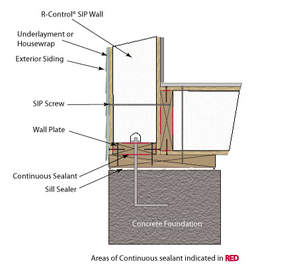DENVER, CO--(Marketwire - January 25, 2011) - Building with Structural Insulated Panels (SIPs) is becoming increasingly popular, due to the many advantages to builders and building owners. ACH Foam Technologies, the manufacturer of energy-saving R-Control® SIPs, offers these important tips for building with SIPs, based on the most common errors made by builders.
1. Pre-Plan Electrical & Equipment Needs
Since SIPs are manufactured to meet the project's specifications, it's extremely beneficial to plan for electrical chases in advance to prevent time consuming and sometimes costly changes for modifications during installation. For example, SIP facings should never be cut horizontally for the installation of electrical wiring. Cutting the panels will compromise the structural performance. If the project specifies roof panels or wall and floor panels larger than 8' x 8' in size, equipment such as a forklift or crane may be needed.
2. Organize the Panels for Installation
After SIPs are delivered to the jobsite, proper storage, weather protection and handling will help to make the installation process more efficient. First, set aside a level spot to store the SIPs and organize them by the sequence in which they are installed. Lay the panels flat, no closer than three inches to the ground and give them plenty of support. Panels should be stacked so that identifying marks can be easily read. Always keep SIPs dry when stored on site by covering them with a breathable protective covering.
3. Follow Proper Installation & Sealing Recommendations
SIPs need to be fully supported. The panel slips over a wall plate, which needs to be set half an inch from the building edge to ensure that the OSB facings and panels are fully supported. Next, set panels in place in order -- start in the corners or valleys and work your way out. Once the panels are installed, joints and voids must be properly sealed using adhesive or SIP tape to minimize air leakage and most importantly to maintain the structure's long-term durability.
4. Protect the SIP Panels from Weather Penetration
Once the SIPs have been installed and sealed, weather protection such as housewrap will prevent moisture deterioration. Windows, openings and penetrations require proper flashing and sealants. Improperly installed flashings can result in trapped moisture. Flash all penetrations; windows over time will eventually leak some water at the window sill. Installing flashing under and around windows and doors will direct water away from the wall structure.
5. Sizing up Your HVAC
One common mistake when building with SIPs is underestimating the high insulating and air sealing properties of SIPs when selecting an HVAC system. SIPs allow for smaller HVAC equipment. When working with an HVAC contractor, make sure they take into account an estimate for low levels of air infiltration. Proper HVAC sizing is critical because an underused system will fail to reach a steady operating rate, resulting in short cycling -- which is less energy efficient and requires more maintenance.
For more information about structural insulated panels visit www.achfoam.com/structuralinsulatedpanels.aspx.
Contact Information:
Sue Rose
Rose Public Relations
303.593.0640
Sue@SueRosePR.com
